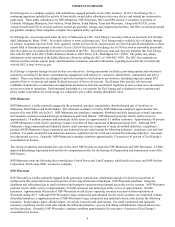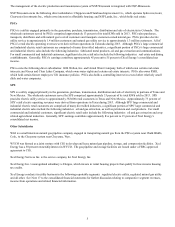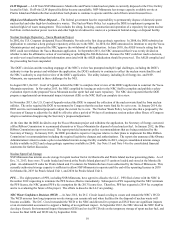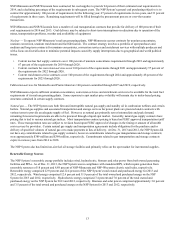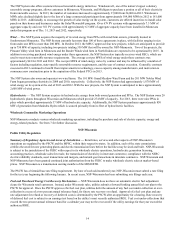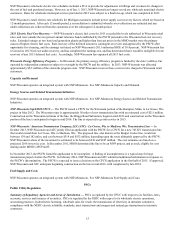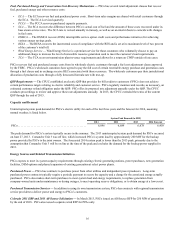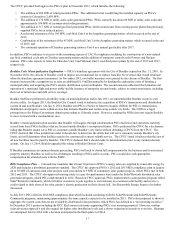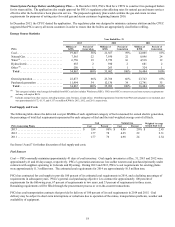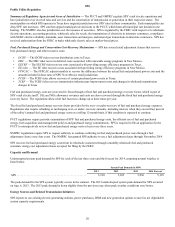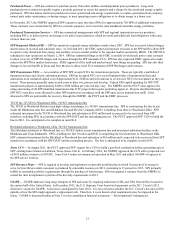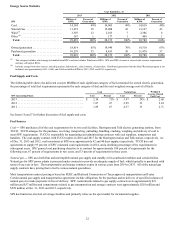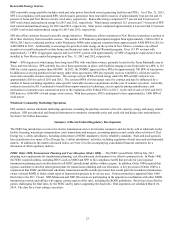Xcel Energy 2013 Annual Report Download - page 32
Download and view the complete annual report
Please find page 32 of the 2013 Xcel Energy annual report below. You can navigate through the pages in the report by either clicking on the pages listed below, or by using the keyword search tool below to find specific information within the annual report.14
The NSP System also offers customer-focused renewable energy initiatives. Windsource®, one of the nation’s largest voluntary
renewable energy programs, allows customers in Minnesota, Wisconsin, and Michigan to purchase a portion or all of their electricity
from renewable sources. In 2013, the number of customers increased to approximately 37,000 from 24,000 in 2012. Windsource
MWh sales declined slightly due to the loss of a large commercial participant from approximately 184,000 MWh in 2012 to 181,000
MWh in 2013. Additionally, to encourage the growth of solar energy on the system, customers are offered incentives to install solar
panels on their homes and businesses under the Solar*Rewards® program. Over 679 PV systems with approximately 7.3 MW of
aggregate capacity and over 561 PV systems with approximately 6.3 MW of aggregate capacity have been installed in Minnesota
under this program as of Dec. 31, 2013 and 2012, respectively.
Wind — The NSP System acquires the majority of its wind energy from PPAs with wind farm owners, primarily located in
Southwestern Minnesota. The NSP System currently has more than 100 of these agreements in place, with facilities ranging in size
from under one MW to more than 200 MW. In October 2013, the MPUC approved four new projects, which are anticipated to provide
up to 750 MW of capacity, including two projects totaling 350 MW that will be owned by NSP-Minnesota. Two of the projects, the
Pleasant Valley wind farm in Minnesota and the Border Winds wind farm in North Dakota are expected to be operational by 2015. In
addition to receiving purchased wind energy under these agreements, the NSP System also typically receives wind RECs, which are
used to meet state renewable resource requirements. The average cost per MWh of wind energy under these contracts was
approximately $41 for 2013 and 2012. The cost per MWh of wind energy varies by contract and may be influenced by a number of
factors including regulation, state-specific renewable resource requirements, and the year of contract execution. Generally, contracts
executed in 2013 continued to benefit from improvements in technology, excess capacity among manufacturers, and motivation to
commence new construction prior to the expiration of the Federal PTCs in 2013.
The NSP System also owns and operates two wind farms. The 101 MW Grand Meadow Wind Farm and the 201 MW Nobles Wind
Farm began generating electricity in 2008 and 2010, respectively. Collectively, the NSP System had approximately 1,870 MW of
wind energy on its system at the end of 2013 and 2012. With the new projects, the NSP System is anticipated to have approximately
2,600 MW of wind power.
Hydroelectric — The NSP System acquires its hydroelectric energy from both owned generation and PPAs. The NSP System owns 20
hydroelectric plants throughout Wisconsin and Minnesota which provide 274 MW of capacity. For 2013, there were nine PPAs in
place which provided approximately 37 MW of hydroelectric capacity. Additionally, the NSP System purchases approximately 850
MW of generation from Manitoba Hydro which is sourced primarily from its fleet of hydroelectric facilities.
Wholesale Commodity Marketing Operations
NSP-Minnesota conducts various wholesale marketing operations, including the purchase and sale of electric capacity, energy and
energy-related products. See Item 7 for further discussion.
NSP-Wisconsin
Public Utility Regulation
Summary of Regulatory Agencies and Areas of Jurisdiction — Retail rates, services and other aspects of NSP-Wisconsin’s
operations are regulated by the PSCW and the MPSC, within their respective states. In addition, each of the state commissions
certifies the need for new generating plants and electric transmission lines before the facilities may be sited and built. NSP-Wisconsin
is subject to the jurisdiction of the FERC with respect to its wholesale electric operations, hydroelectric generation licensing,
accounting practices, wholesale sales for resale, the transmission of electricity in interstate commerce, compliance with the NERC
electric reliability standards, asset transactions and mergers, and natural gas transactions in interstate commerce. NSP-Wisconsin and
NSP-Minnesota have been granted continued joint authorization from the FERC to make wholesale electric sales at market-based
prices. NSP-Wisconsin is a transmission owning member of the MISO RTO.
The PSCW has a biennial base rate filing requirement. By June of each odd numbered year, NSP-Wisconsin must submit a rate filing
for the test year beginning the following January. In recent years, NSP-Wisconsin has been submitting rate filings each year.
Fuel and Purchased Energy Cost Recovery Mechanisms — NSP-Wisconsin does not have an automatic electric fuel adjustment
clause for Wisconsin retail customers. Instead, under Wisconsin rules, utilities submit a forward-looking annual fuel cost plan to the
PSCW for approval. Once the PSCW approves the fuel cost plan, utilities defer the amount of any fuel cost under-collection or over-
collection in excess of a two percent annual tolerance band, for future rate recovery or refund. Approval of a fuel cost plan and any
rate adjustment for refund or recovery of deferred costs is determined by the PSCW after an opportunity for a hearing. Rate recovery
of deferred fuel cost is subject to an earnings test based on the utility’s most recently authorized ROE. Fuel cost under-collections that
exceed the two percent annual tolerance band for a calendar year may not be recovered if the utility earnings for that year exceed the
authorized ROE.


